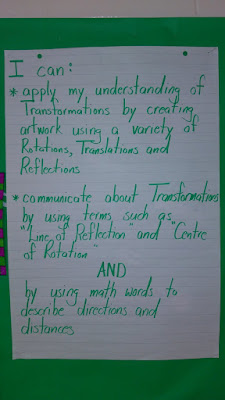Creating Art Using Geometric Transformations
We expect a lot from students. In math, there is an emphasis on thinking, problem solving, communicating thoughts using mathematical language, trying, making mistakes, evaluating, trying again and re-evaluating. It is all part of the mathematical process, but, I often find that students get frustrated by the long bouts of concentration required of them.

I've begun to put more of an emphasis on art in my math classes. The art, of course, is directly related to the unit of study.
Recently, I had my class investigate Transformations through art. They had two objectives. The first was to use Rotations (Turns), Reflections (Flips) and Translations (Slides) to design a piece of art. The second was to explain their artwork using mathematical language during a student/teacher conference.
Before beginning, students investigated art from different cultures and found many examples of geometric art where the patterns relied on transformations of congruent shapes.
The examples shown are from Grade 6 students.
 |
 |
 |
 |
There is a great deal of math thinking that goes into well composed artwork. Shapes need to be spaced out evenly and centered. That involves measuring, planning, rough work, making
mistakes and trying again.
Students demonstrated a variety of examples of each translation. For example, some rotations involved centers of rotation within the shape, others had centres of rotation on a shape's vertex, while centres of rotation outside of the shape were also used.
This project took my class about three weeks to complete. They did not work on it from start to finish. Instead, it was something that they would return to over and over again.
Sometimes they used the project for down time - colouring with a friend - when they needed a break. Other times, an idea might pop into their head and they would put down what they were doing to incorporate their thinking before they forgot about it.
Spending a long amount of time on the project had many benefits. It allowed students to review ideas in their head after the instructional component of the Transformations Unit was over. As mentioned above, it gave students a chance for "productive down time" and an outlet for their creative spark. It also gave students an opportunity to really investigate what each other were doing. Ideas were talked about informally as students shared their artwork and their thinking when they wanted to.
Art and Math share a long history. The combination gives students opportunities for projects that really do connect to "the real world."

No comments:
Post a Comment